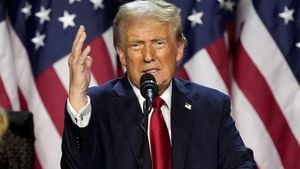Jake Paul and Mike Tyson brought their unique worlds of boxing together on November 15, 2024, as they faced off in Texas for what was dubbed an intergenerational showdown. The event took place at the impressive AT&T Stadium, home of the Dallas Cowboys, and marked Tyson's first sanctioned fight since 2005. The bout was streamed live on Netflix, which boasts over 280 million global subscribers, ensuring it reached audiences far and wide.
The fight, scheduled for eight rounds, featured the 58-year-old former heavyweight champion Tyson against the much younger Paul, who is now 27. Although it drew substantial attention, the fight failed to meet the high expectations set by promotional hype surrounding such a clash of eras. Despite moments of excitement, the technical quality of the competition raised eyebrows among boxing purists.
Paul, who has made a name for himself as both an influencer and boxer, entered the ring with a professional record of 10 wins, one loss, and seven knockouts. Tyson, the notorious ex-champion known for his ferocity in the ring, previously retired with 50 wins, six losses, and 44 knockouts. The stark age difference highlighted the nature of this unique matchup—a merging of the old boxing guard with the new, represented by Paul, who emerged from the social media scene.
This bout wasn't just about two fighters facing off. It served as a spectacle, showcasing how far boxing has evolved—from traditional settings to glamorous pay-per-view events supported by streaming services like Netflix. A historical rematch also took place on the same night, featuring Katie Taylor against Amanda Serrano for the undisputed women's super lightweight championship, adding to the event's prestige.
But not everything was smooth sailing. Tyson's pre-fight experience was marked by controversy, particularly during the weigh-in when he slapped Paul, capturing headlines and stirring excitement. Tyson's surging emotions and passion were palpable as he approached the bout, reflecting on his return to the ring after his 2020 exhibition match against Roy Jones Jr., where he found the thrill of boxing rekindled.
The fight had initially been scheduled for July 20 but was postponed due to Tyson suffering from a stomach ulcer. One could argue, this added layers of anticipation as fans were eager to see how their legendary champion would perform after such health challenges.
Financially, the stakes were high, with reports indicating Paul could earn around $40 million, compared to Tyson's estimated $20 million. These staggering figures exemplify how far both fighters have come, albeit from different paths, redefining what it means to be a boxer today. Despite Tyson's complicated history with wealth and legal troubles, he claimed financial motivation was not his primary drive. The event's significance transcended mere monetary gain.
The audience present at the AT&T Stadium was diverse, encompassing both traditional boxing fans and younger viewers attracted to Paul's social media influence. Engaging such varied demographics showcased boxing's potential to adapt and thrive, attracting new audiences and retaining loyal fans.
Before delving back to the fight itself, it's important to mention the excitement surrounding the promotion. Tyson and Paul appeared at multiple events leading up to the fight to build up the atmosphere, drawing on their dramatic personas to capture public interest. Their interactions propelled narratives seen on social media and traditional platforms alike.
Despite criticisms, the event undeniably captured the collective imagination. The dynamics of this fight straddled entertainment and athleticism, highlighting key aspects of why boxing remains one of the most captivating sports worldwide. The sweet science has always thrived on unpredictability, and this fight promised just the right amount of drama and flair with Paul and Tyson at its heart.
Post-fight assessments pointed to what this matchup meant for the sport moving forward. Tyson's involvement confirmed his continued relevance within the sporting world, validating the trend of seasoned athletes crossing over to mainstream or social media-driven platforms. Paul brings with him the idea of reinventing boxing, where matches are no longer dictated by conventional pathways but instead, creativity and marketing prowess as influential factors.
At the end of the day, whether you viewed the fight as legitimately competitive or merely entertainment, it drew attention and sparked conversations about the future of boxing. The clash between age and youthful exuberance, legacy and new beginnings, remains the essence of boxing, albeit through the lens of social media engagement.
For boxing purists, this blend of traditional sport with modern marketing tactics might leave them uneasy, but audiences—certainly younger ones—seem ready to embrace this evolution. It's worth pondering what paths future bouts will take. How the sport will adapt remains to be seen, but events like this signal clear progression. If anything, the matchup between Jake Paul and Mike Tyson this past November has taught us about the ability of boxing to reinvent itself.



